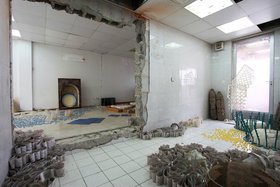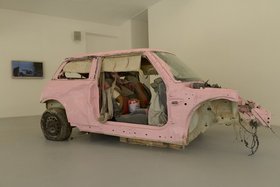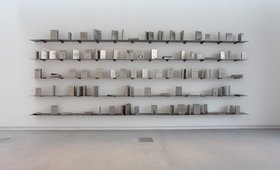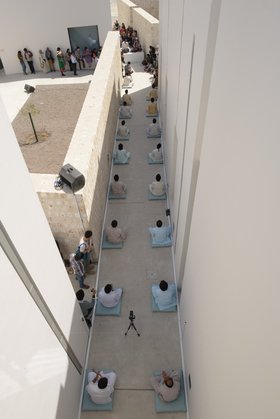Interviews
Representing Regions
Sheikha Hoor Al-Qasimi in conversation with Stephanie Bailey
Sheikha Hoor Al-Qasimi grew up with the Sharjah Biennial. She was thirteen when it was conceived (in 1993) and remembers the first editions being held in the Expo Centre. When she graduated from the Slade School of Art in 2002, she travelled to Germany and chanced upon Okwui Enwezor's 2002 Documenta 11. For her, it was a moment she realised what art could do, joining the Sharjah Biennial committee soon after. In 2003, Al-Qasimi co-curated Sharjah Biennial 6 alongside Peter Lewis – an event that saw the biennial move into its current location, the arts and heritage areas. Then, in 2009, the Sharjah Art Foundation (of which Al-Qasimi is president), was established to manage the biennial and develop contemporary art in Sharjah and the region through endeavours including the annual March Meetings and an active exhibition and educational programme. This interview explores the issues surrounding the Sharjah Biennial, one of the region's oldest and most progressive biennials.
Stephanie Bailey: The cultural events produced by the Sharjah Art Foundation – namely, the Sharjah Biennial and annual March Meetings – have been embedded in the issues of developing and supporting contemporary art from in and around the Gulf and Arab regions and beyond. How do you mediate the encounters produced by these events and their local, regional and global contexts?
Hoor Al-Qasimi: You have to think about your audience and we have many audiences. You also have to engage with the public and everything we do is inclusive and free, from our events, concerts, screenings and exhibitions. We also have exhibitions a few times a year and produce these little booklets rather than catalogues so we can distribute them also for free. It is this dissemination of information. For example, I did an exhibition of works from the collection called In Spite of it All and we had some technicians working in the office and they were taking a break and I saw them in the room reading the catalogue. A few hours later I saw them still reading the book. They were so into it and I thought, these guys just came in to fix something and then they got into it. For me this is important.
SB: Thinking about this kind of interaction, how easy has it been to engage the local public in terms of the languages of contemporary art?
HAQ: It depends. I think you need to make the exhibition approachable in a way, so having things outside that would bring people into the buildings is good, or if you have things that may come across as too intellectual or intimidating, you're alienating a lot of people. There are certain works that could be easy to understand in one way, but still be political or intellectual, on the other. I think works that do that mainly are from music and performances, because people aren't intimidated by going to watch a film or performance.
SB: Yuko Hasegawa had precise intentions for Sharjah Biennial 11 when thinking about the locality in that this has been a biennial with a clear concern for the local community – works such as The Bank by Superflex, a public playground produced using suggestions from local migrants in mind, are a case in point. From your perspective, how is this biennial similar or different to past iterations?
HAQ: It is similar in that from when we moved into the arts area, we have been moving into the heritage area as well, and now we have started occupying courtyards and claiming other spaces [in the area known as The Heart of Sharjah]. We have started to call the whole area the 'SAF (Sharjah Art Foundation) neighbourhood' in the offices, now. I mean, this is our neighourhood and it feels that way. They know us here – the kids who play around, the shopkeepers – and it feels like a neighbourhood. This sense has been lost in many other places.
So as I said, what we had all the time was the heritage area, the arts area and the calligraphy Area. We always used these spaces. But Bank Street was always this 'in-between' place and I wanted to merge it. Yuko [Hasegawa] suggested we have Superflex produce a public park of some kind here, because of the project they did in Copenhagen, so we did that. I also suggested the use of the Islamic Bank building, because I grew up with these buildings and knew that the bank was leaving. So for this biennial, we managed to bridge the two areas between the SAF offices and the heritage area.
In Sharjah, it is always difficult for a curator from outside to know what the city or the country is like because they are flying in for two days at a time and then flying out again. It is important for us at SAF, as a foundation, to be the people who have all the research to make the connections and to make everything available to the curator. I think the team has worked really hard, day and night, working with different organisations and communities in Sharjah. We worked with the Poetry House, the Gulf Studies Centre, the Museum of Islamic Civilization, and even Town Planning, who helped us produce the signage for the street and parking, and the the locals, who Superflex talked to in order to produce their work. There were all these people that we talked to and worked with for different things. Now they call the Sharjah Biennial 'our biennial', which is nice.
SB: I like how you use the words 'claiming' and 'occupying' space. In terms of the issues that surround contemporary art in the UAE, do you see the Sharjah Biennial – and by extension Sharjah Art Foundation – as a project affecting civil society in Sharjah?
HAQ: Definitely, I think so. There is always a fear of over-developing or gentrification, especially with a lot of the old buildings having to be torn down because they do not fit building standards anymore. A lot of them have to be renovated or torn down and rebuilt. So for my father to have saved so many of these buildings in Sharjah, to rebuild and conserve the city's architecture, is really important because it brings a context to Sharjah. It reminds people of the history of the trade route and how Sharjah was an important place politically and geographically. For me, it is important to use this information in the biennial. It is one of the reasons why our artist residency program is really important to us, because the public can relate to something when it is about their culture.
SB: Thinking about the critiques that came out of the 2011 Sharjah Biennial and Hasegawa's theme this year, the metaphor of the courtyard garden gives this idea of space being something where the 'public' and 'private' are not in binary opposition. Was this year's approach somehow informed by what happened in 2011, given the response from the public to some of Sharjah Biennial 10's more controversial works and moments? I'm thinking here about Mustapha Benfodil's public installation, It Is Of No Importance, which was removed due to its blasphemous content.
HAQ: With public installations, you want the people to come together and discuss it. If you have something offensive and illegal, you can't do that. In 2011, the police came and were going to shut us down and arrest everyone, basically. People don't realize that this was actually illegal and that it was not political, it was blasphemy. This was against UAE law, not 'Sharjah Biennial law'. And I think, if you want to alienate your audience, then why are you are there. If you are there just to have you own club and show art to elite visitors who fly in and fly out, to even present something in a beautiful setting, you could do this any where in the world. In the end, for us what happened was a call from our community saying, 'look this is offensive to us'. They weren't angry: they were very civil about it, but it happened, we dealt with it and that was it.
SB: Right. And when I asked about how the Sharjah Art Foundation and the Sharjah Biennial are embedded politically, it was because one of the most interesting things about the Sharjah Biennial 10 in 2011 was that an audience coming from outside was somehow imposing its opinions and ideas on a specific and very particular situation pertaining to the particularity of Sharjah, the UAE and the Gulf by wider implication.
HAQ: Exactly, and who is to say whose ideas are better or correct? I feel if the local people are saying, 'you are offending us', then we have a right to speak about that: it is freedom of speech. They were telling us: 'we don't want this in our backyard or behind the Iranian mosque, and we have a right to voice that.' There are no problems between the sects in the Emirates. There are people from Iran who are Shia and local people who are Sunni, but they live next to each other. So why create problems that could happen by almost defacing this mosque because an offending work has been installed behind it? So, with regards to 2011, there were all these things happening, but I don't want to lose my public. We are here as part of the government and as a service to the community. That's why we do all our events for free because we aren't here to make money or to build 'members'.
SB: I find it interesting how Hasegawa, in her proposal for Re:emerge, Towards a New Cultural Cartography, is not so much asserting a 'Global South' as she is bringing to light forgotten histories. It feels more like a reminder of the fact that visitors are in another situation, context and society. Is this something to take into account when thinking about art when it is presented within the region?
HAQ: Well every culture has its own evolution, its own rules and its own lifestyles. When you travel to another country, you are sensitive to their culture. You don't sit and criticise, though some people do. But if you are well-travelled, which many people claim to be, then you would respect the laws of the culture, no matter where it is that you visit. Some people don't. They like to look at certain countries and regions – China, the Middle East, Iran and so on – and it's all censorship, censorship, censorship; but what about that Brooke Shields incident for example? [Richard Prince's approproation of an image of a young Brooke Shields by Gary Gross titled Spiritual America (1983), removed from the 2009 Tate Modern exhibition Pop Life for breaching obscenity laws]. Or what about the Smithsonian incident [the removal of David Wojnarowicz's video work A Fire in My Belly (1986-7) from Hide/Seek, a 2010 exhibition at the National Portrait Gallery in Washington D.C.], even though that is another story completely? It is a very one-sided view. But, you know – we are used to this here.
SB: Then there are the ideas that arise from the context of Sharjah: ideas of the postcolonial and these very complex, mixed heritages that aren't so black and white.
HAQ: Exactly.
SB: But when you think about how cultures relate to each other in the twenty-first century, how do we accept differences and how do we essentially relate on a global level? How do you see this in terms of the Sharjah Biennial and its function in Sharjah?
HAQ: I think it fits for Sharjah because Sharjah is multi-cultural and global. We have so many different influences from different cultures in our own culture. With food for example, our local dish is biryani. We also have dishes from Zanzibar. We say Indian words in our language, so I was really happy to go to India and be able to say things like 'straight', 'goat', 'quickly', or 'rubbish', because growing up we would use these words in our language – we picked them up as children. Of course, other Arabs wouldn't understand because it is not Arabic: it is Hindi.
SB: And these influences lead back to the legacy of Sharjah as a trading post?
HAQ: Yes, exactly. And people don't think about this history. My father is a historian, he has two PhDs in History and Geography, and he has written 43 books. For him, this is important and he is constantly writing, thinking about how these stories will be lost some day if he doesn't write them down. I mean, again, I feel like this approach fits for Sharjah. I am also confused with my own modern tongue. I grew up speaking Tagalog and English was my first language at school, Arabic was my second and then French and Japanese…
SB: This positions the U.A.E. in its context and the complexity that comes with it. I was at the SB11 film screenings, including one by filmmakers from the Philippines. It was great being exposed to this work – it was incredibly particular. The fact that these were original commissions, was fantastic too, given how the Philippines art world comes with its own issues. But these issues aren't only in terms of support for the arts, but also in terms of how the country is dealing with its postcolonial condition, as much as the U.A.E. is. It feels like the Sharjah Art Foundation is reaching out beyond what is traditionally known as 'the region' so as to expand on current discourses affecting the region. But in thinking about this, even the term 'the region' is itself confusing given the disparate nations and territories included within said 'region'.
HAQ: Definitely. I feel like our region is confusing because people here are from everywhere. Afghanistan is in our region, Indonesia is in our region – but when I say that, people look at me like I'm crazy. But for me, if these people live in Sharjah, then they are in our region!
SB: This raises the issues surrounding the terminology being used to describe the 'region' itself. Is it North Africa and the Middle East, does it include South Asia, and, as Payam Sharifi suggested, Central Asia, too? You are never quite sure where 'the region' is grounded. Though you have the acronym MENA for instance.
HAQ: Yes. And you could say the same for 'MENASA'. When you talk about 'The MENASA', I would say, hang on a minute: what about Sudan? There is a huge Sudanese population here, too, in the U.A.E. And what about Mauritania? What if I decided that this also constituted our region? Why do you have to refer to it as MENA or MENASA? It is just global, I think. Our Region.
Hoor Al-Qasimi, President of the Sharjah Art Foundation, is a practicing artist who received her BFA from the Slade School of Fine Art, London (2002), a Diploma in Painting from the Royal Academy of Arts (2005) and an MA in Curating Contemporary Art from the Royal College of Art, London (2008). She is on the Board of Directors of MoMA PS1, New York and Ashkal Alwan, Beirut, and was on the curatorial selection committee for the 2012 Berlin Biennial. Her recent curatorial projects include Drift – an exploration of urban and suburban landscapes (2011), and In Spite of it All (2012). A solo exhibition of her photographic work Off Road opened recently at the Nevada Museum of Art, Reno.









